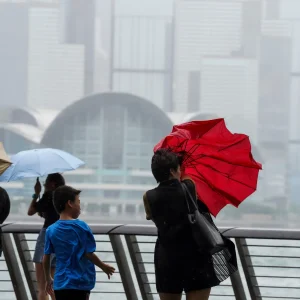
HKU Jockey Club Enterprise Sustainability Global Research Institute
World-Class Hub for Sustainability

Hong Kong Economic Policy Green Paper 2025
As a coastal city with low-lying terrain, Hong Kong is frequently affected by extreme weather events and has experienced multiple climate disasters in the past decades. Two climate risks are particularly concerning: the occurrence of severe typhoons and rising sea levels. In this regard, we focus on how typhoons and sea level rises would affect public housing and conduct scenario analysis on the potential economic losses under different climate pathways. Our analysis shows that the potential damages caused by sea level rise can be more severe, especially in the long run. Under high carbon-emissions pathway, it is also projected that the asset loss due to sea level rise for the three selected public housing estates would be significantly higher than that caused by typhoons.
If climate risks are tackled appropriately, they can be transformed into development opportunities. We propose seven major policy recommendations for Hong Kong to better adapt to climate change: 1) Promote data integration, create a geo-coded platform, to comprehensive climate-risk analysis; 2) Conduct adaptative retrofits for old buildings and infrastructures, and consider sea level rise for new buildings locations; 3) Target vulnerable groups; 4) Improve the climate disaster prediction, warning and response system; 5) Develop the climate catastrophe insurance and reinsurance market; 6) Support early-stage climate-tech companies and application of climate-adaptation technologies; 7) Pay attention to transition risks towards net-zero future.

1. Overview of Climate Risks in Hong Kong
Hong Kong has been warming up in the last century. Analysis from the Hong Kong Observatory (HKO) showed that the average mean temperature has increased by 0.14°C per decade from 1885 to 2023.
That number reached 0.30°C per decade from 1994 to 2023. Consistent with this trend, the annual average number of hot nights from 2001 to 2023 has increased by 67.18%, while the number of cold days has decreased by 18.19%, relative to 1991-2000 averages. The sea level is also steadily rising, with a growth rate in mean sea level of 31 mm per decade at Victoria Harbor from 1954 to 2023.
Meanwhile, Hong Kong has experienced more typhoons and heavy rainfall in the last two decades. These weather events, including storm surges, strong winds and coastal flooding, have caused significant damages.

2. Case study: Future Climate Risks and Public Housing in Hong Kong
There is an urgent need to understand what the future climate will look like in Hong Kong and how various climate risks will affect the economy. Constrained by our research capacity, we cannot provide a comprehensive assessment in this report. Instead, we pick a few high-risk locations in Hong Kong and demonstrate how granular climate data and climate-risk analysis can be helpful for decision-making. Moreover, we focus on one specific type of property: public housing. The reason for analyzing public housing is twofold.
First, most of Hong Kong’s vulnerable groups, including low-income (Census and Statistics Department of the Government of HKSAR, 2024), high-density (GovHK, 2022), and elderly (Peng and Maing, 2021) populations, live in public housing units. These groups often have the least knowledge and capacity to understand and respond to climate risks. Second, public housing is owned by the government, so our analysis can have direct policy implications.

3. Policy Implications
If climate risks are tackled appropriately, they can be transformed into development opportunities. To better adapt to climate change, we provide the following policy recommendations.
1. Data Integration and Comprehensive Climate-Risk Analysis
2. Adaptative Retrofits for Old Buildings and Infrastructures
3. Targeting Vulnerable Groups
4. Improving the Climate Disaster Prediction, Warning and Response System
5. Developing the Climate Catastrophe Insurance and Reinsurance Market
6. Supporting Early-Stage Climate-Tech Companies and Application of Climate- Adaptation Technologies
7. Paying Attention to Transition Risks

1. Overview of Climate Risks in Hong Kong
Hong Kong has been warming up in the last century. Analysis from the Hong Kong Observatory (HKO) showed that the average mean temperature has increased by 0.14°C per decade from 1885 to 2023.
That number reached 0.30°C per decade from 1994 to 2023. Consistent with this trend, the annual average number of hot nights from 2001 to 2023 has increased by 67.18%, while the number of cold days has decreased by 18.19%, relative to 1991-2000 averages.The sea level is also steadily rising, with a growth rate in mean sea level of 31 mm per decade at Victoria Harbor from 1954 to 2023.
Meanwhile, Hong Kong has experienced more typhoons and heavy rainfall in the last two decades. These weather events, including storm surges, strong winds and coastal flooding, have caused significant damages.

2. Case study: Future Climate Risks and Public Housing in Hong Kong
There is an urgent need to understand what the future climate will look like in Hong Kong and how various climate risks will affect the economy. Constrained by our research capacity, we cannot provide a comprehensive assessment in this report. Instead, we pick a few high-risk locations in Hong Kong and demonstrate how granular climate data and climate-risk analysis can be helpful for decision-making. Moreover, we focus on one specific type of property: public housing. The reason for analyzing public housing is twofold.
First, most of Hong Kong’s vulnerable groups, including low-income (Census and Statistics Department of the Government of HKSAR, 2024), high-density (GovHK, 2022), and elderly (Peng and Maing, 2021) populations, live in public housing units. These groups often have the least knowledge and capacity to understand and respond to climate risks. Second, public housing is owned by the government, so our analysis can have direct policy implications.

3. Policy Implications
If climate risks are tackled appropriately, they can be transformed into development opportunities. To better adapt to climate change, we provide the following policy recommendations.
1. Data Integration and Comprehensive Climate-Risk Analysis
2. Adaptative Retrofits for Old Buildings and Infrastructures
3. Targeting Vulnerable Groups
4. Improving the Climate Disaster Prediction, Warning and Response System
5. Developing the Climate Catastrophe Insurance and Reinsurance Market
6. Supporting Early-Stage Climate-Tech Companies and Application of Climate- Adaptation Technologies
7. Paying Attention to Transition Risks